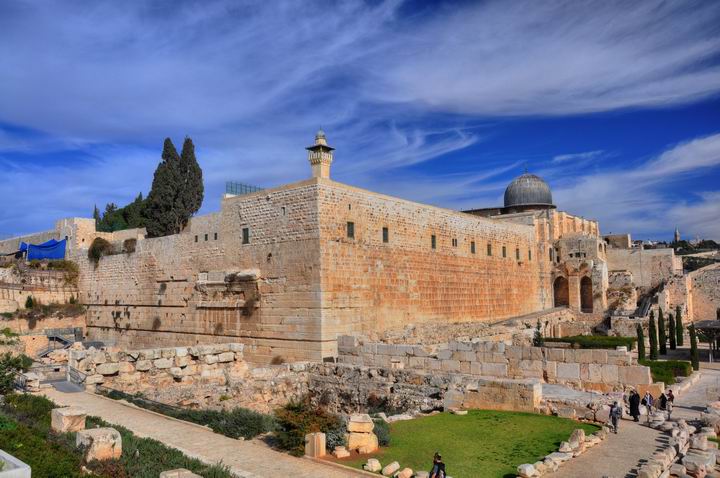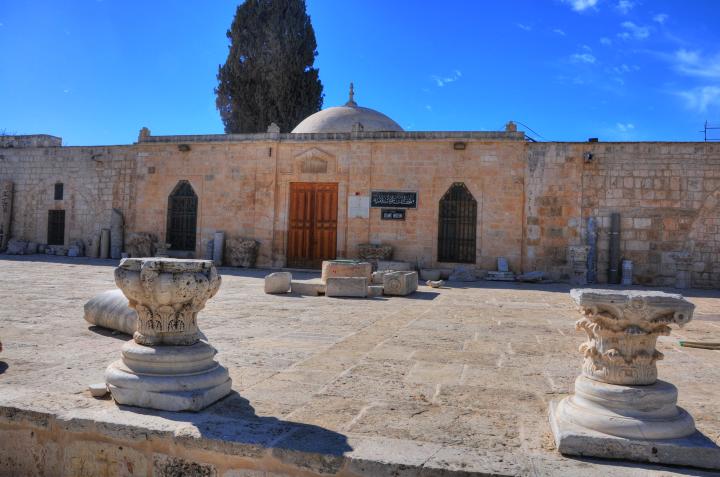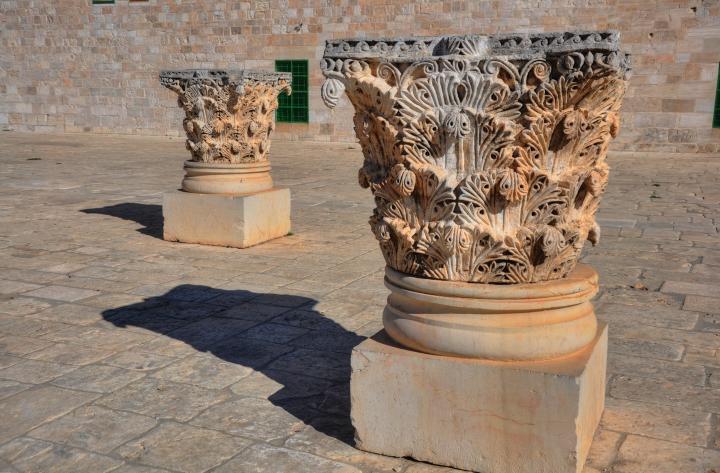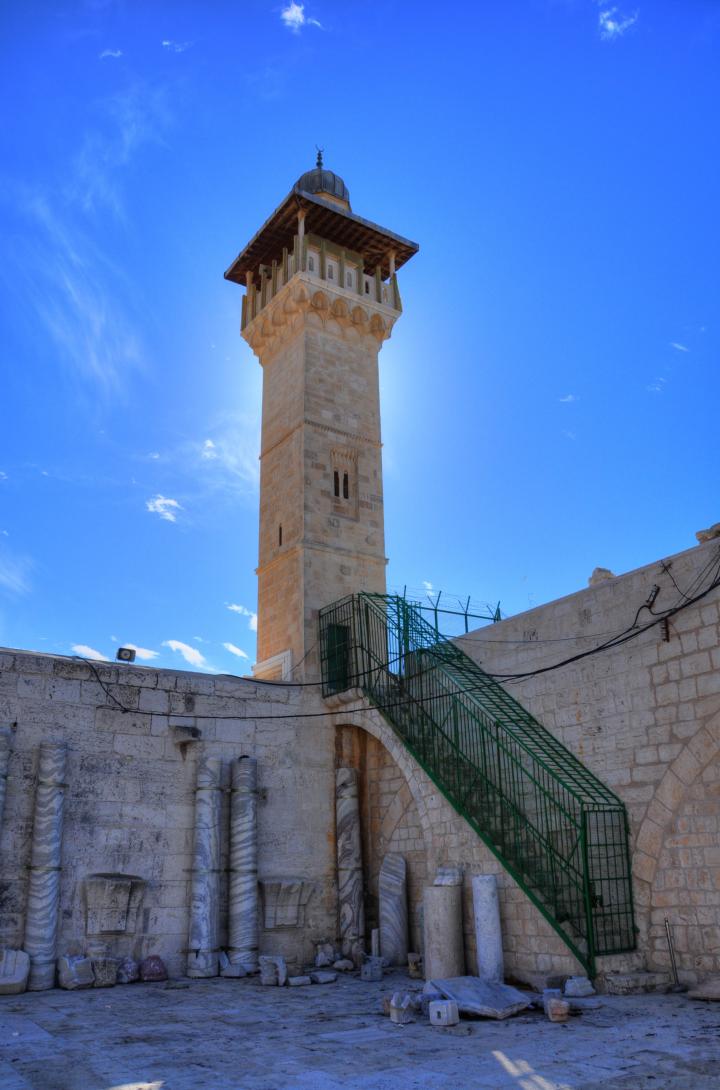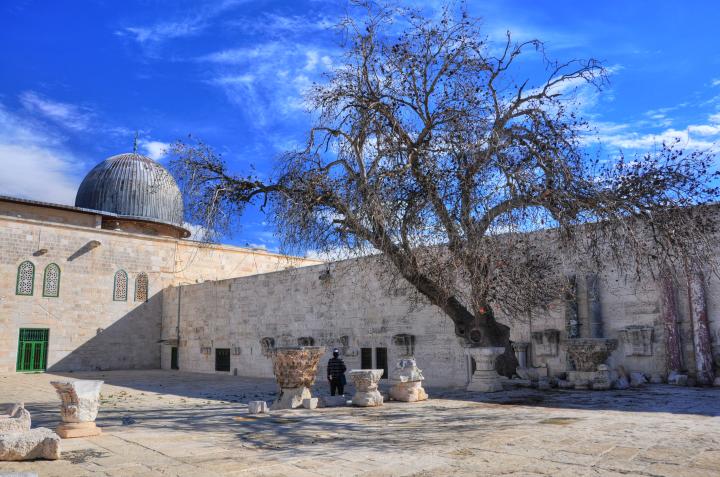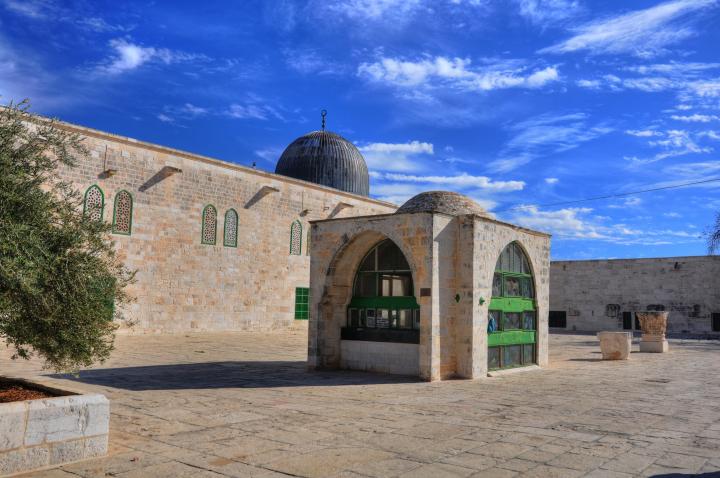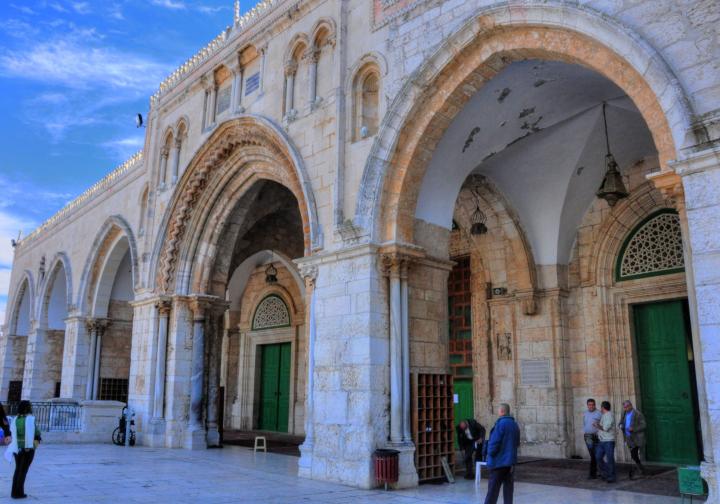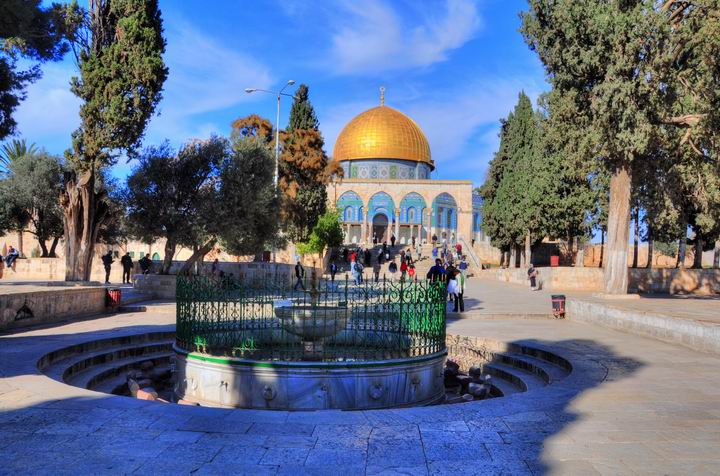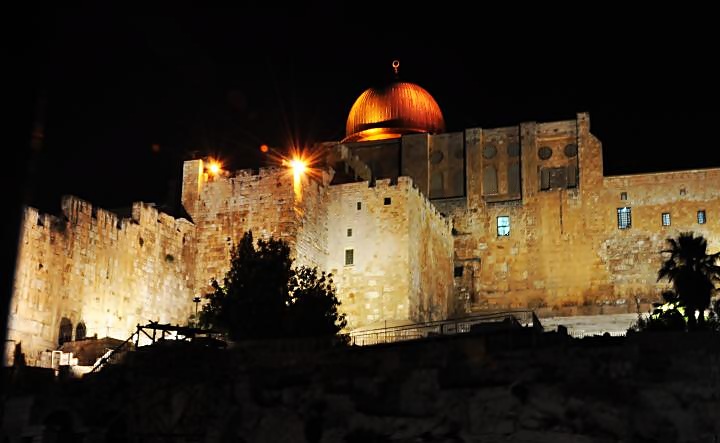Al-Aqsa (“the farthest”) mosque is located on the southern side of the temple mount, and is the 3rd most holiest site in Islam. It is named after the Muslim’s account of the night travel of prophet Muhammad to the remote mosque.
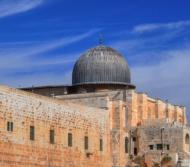
Home > Sites > Jerusalem > Temple Mount> Al-Aqsa (Al Aksa)
Contents:
Overview
Location
History
Plan
Photos
* General
* Museum
* Minaret
* Western
* North
* Light Show
Etymology
References
Links
Overview:
Al-Aqsa (“the farthest”) Mosque is located on the southern side of the temple mount, and is the 3rd most holiest site in Islam. Initially built in 705 AD, the present silver-dome structure dates to 1035 AD. It is named after the Muslim’s account of the night travel of prophet Muhammad, who according to their tradition was transported from Mecca to Jerusalem.
Location:
The mosque is located on the southern edge of the Temple mount. It is accessed from the temple mount for Muslims, or through the nearby Mugrabi gate for other faiths during regulated hours between the prayers.
History of the place:
-
Biblical period
According to some scholars, during the 10th Century BC this was the location of King Solomon’s “house of the forest of Lebanon”, as described in the Bible (1 Kings 7 1-7): “…He built also the house of the forest of Lebanon”.
-
Roman Period
The area of the al-Aqsa mosque was part of the great second temple which was built in 20BC by Herod the Great, King of Israel under the Romans (37 BC – 4 BC). After the Romans crushed the great revolt (70AD), the temple was leveled and was in ruins until the end of the Byzantine period.
-
Arab period
The Arabs conquered Jerusalem in 638 AD, and Khalif Omar visited and prayed in the site in that year. The dome of the Rock shrine, with the large golden dome and an octagon structure, was built by the Umayyad Khalif Abdul-Malik ibn Marwan in 691 (72 year according to Muslim calendar), and named it after Omar. It is one of the most beautiful and enduring shrines in the World, and remained almost untouched throughout the years. The rock is, according to Muslim tradition, the spot where prophet Mohamed ascended to heaven.
Years later, either in 696 (by the same Khalif) or in 705 AD (by his son), another dome was built on the far south side: the Al-Aqsa mosque (also “Al-Aksa”, which means “the remote” mosque). It was named after the tradition of prophet Muhammad’s imaginative night travel from Mecca to a remote mosque (Qur’an Night Journey 17 1): “Glory be to Him Who made His servant to go on a night from the Sacred Mosque to the remote mosque of which We have blessed the precincts, so that We may show to him some of Our signs; surely He is the Hearing, the Seeing”.
After the mosque was destroyed in the great earthquake of 749, it was repaired by 780. Following another devastating earthquake (1033) it was rebuilt (1035), which is the present day structure.
-
Crusaders
In 1099 the Crusaders called the Temple mount as “Templum Domini”, turned the Dome of the rock to a church, adding a cross on the dome. They turned the Al-Aqsa mosque to a prayer house and then to Baldwin’s royal palace in 1104, naming it King Solomon’s palace.
The Templar Knights military-religious organization was established in 1118, and named their organization after the temple. The vast halls under Al-Aqsa mosque was believed to be King Solomon’s stables, a name still used today in the area that the was cleared under the mosque.
The Crusaders were driven out from Jerusalem by Saladin in 1187.
-
Modern Years
The Dome of the Rock shrine and the al-Aqsa mosque remain active until today. In 1967 Israel reunited Jerusalem, but left the control of the temple mount to the Muslim Wakf. From time to time there are religious and political frictions ignited at the site, for example the riots in year 2000 that sparked the 5-years Palestinian uprising, called the “Al-Aqsa Intefada”. The situation seems explosive almost periodically, and the Israeli police staffs thousands of policemen in some Fridays, limiting the age and residence of the allowed persons to enter the temple mount in order to reduce the friction. There are some extreme Jewish groups who want to rebuild the “third temple”, but this is a small group which is limited by the authorities. In addition, there are political debates over the fate of the city, which spells out more trouble in this hot spot.
Plan:
The figure illustrates the plan of the southern side of the temple mount, indicating the major sites. The Al-Aqsa mosque is in the center of the south wall, and is capped by a silver dome.
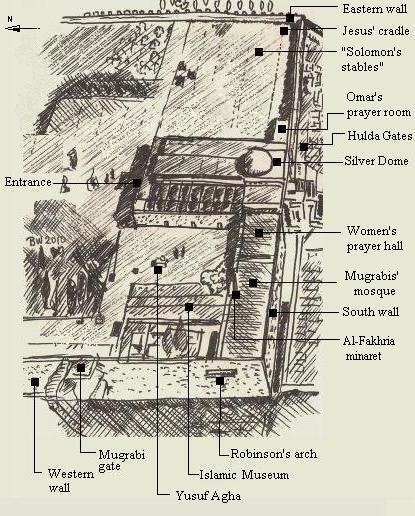
After entering the main entrance on the north side, there is a large colonnaded praying hall.
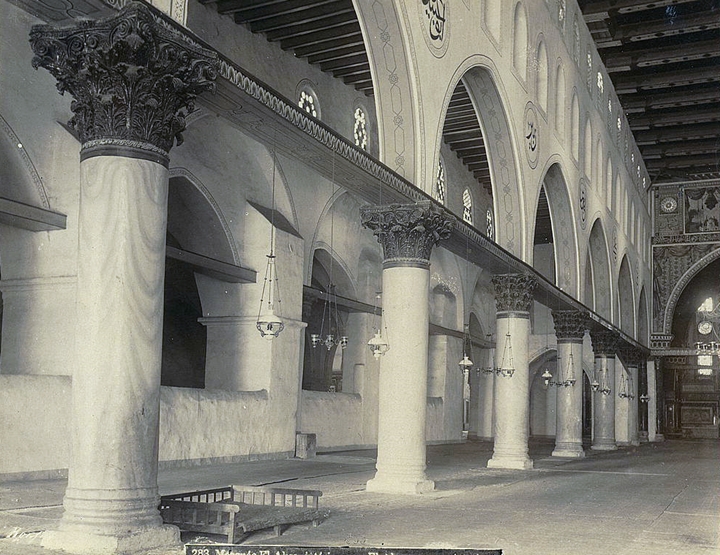
Colonnaded prayer hall [ Dated: 1867; Maison Bonfils, photographer ; Library of Congress]
The mosque’s southern side is attached to the temple mount south wall. A prayer niche – Mihrab – is installed on the south wall, directed towards the Islam Holy cities of Mecca and Medina.
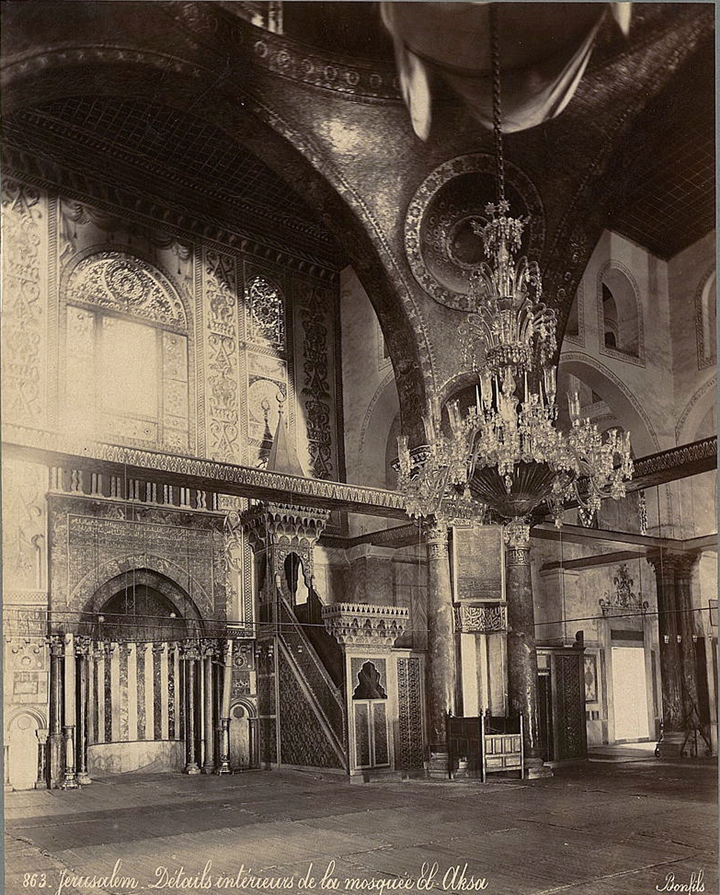
Al-Aksa mosque – Mihrab [ Dated: 1867; Maison Bonfils, photographer ; Library of Congress]
Outside the mosque:
On the west side of the mosque is a women’s prayer all, a Mugrabi mosque, and the Islamic Museum.
On the east side of the mosque is a large open area, with underground halls named “Solomon’s stables”.
Photos:
(a) General View
The south-west side of the temple-mount is seen in the photo below. The Al-Aqsa mosque, with its silver dome, is located on the southern wall.
Click on the photos to view in higher resolution…
The photos are organized in the order from west to east.
(b) Museum
The Islamic museum is located on the western side of the Al-Aqsa. It was established in 1923 and transferred to this location in 1927.
Corinthian capitals are on display in the yard between the museum and the Al-Aqsa mosque.
(c) Minaret
A tower, the Al-Fakhria minaret, is located on the south-west corner of the temple mount. The minaret tower (from Arabic: Manara =lighthouse) is a distinctive architectural feature of an Islamic mosque, and used for calling for prayers and a visual landmark. The temple mount has a total of four minarets – al-Fakhria (this tower), Bab al-Asbat (on the north-side overlooking Bethesda), al-Ghawanmeh (on the north-west side) and Bab al-Silsilah (on western wall).
Marble columns and other archaeological items, part of the Museum, are on display along the walls.
(d) Western side of Al-aqsa
Inside the temple mount, on the western side of the Al-Aqsa mosque, is the court yard of the Islamic museum and the mosque of the Mugrabis (westerners).
Another view of the western side of the mosque is seen in the following picture. The small structure in the center of the courtyard is called the dome of Yusuf Agha, a small (5m x 5m) structure which was erected in the 17th C by Yusuf, the Ottoman Chief Eunuch (term 1671-1687).
(e) North side
The entrance to the mosque is from the north side. To enter into the prayer hall the shoes must be taken off and stored in the wooden box.
Another view of the entrance to the mosque is shown in the following picture.
To the north of the mosque (37m from the entrance) is a small fountain – El-Kas (“the Cup”). It was built by the Mameluke governor of Damascus in 1320, and served the worshippers. The water was fed from an aqueduct that supplied water to the temple, based on the Jerusalem “lower aqueduct” that delivered water to the city in the Roman period, from Solomon’s pools (near Bethlehem) to the temple mount (20KM in total length).
The following photo shows the fountain, the golden Dome of Rock behind its right side, and the “prophet’s olive tree” behind its left side.
(f) Light Show
In June 2010, as part of the Jerusalem Light Festival, the Al-Aqsa mosque and the southern walls were illuminated with a special illumination:
Etymology (behind the name):
-
Al-Aqsa (Al-Aksa) – In Arabic: the “remote” or the “farthest”. The silver dome is built on the southeast side of the temple mount, and is named after the Muslim’s account of the imaginative travel of prophet Muhammad to the remote mosque.
-
Manara(h): Arabic for lighthouse. In English: Minaret – a distinctive architectural feature of an Islamic mosque, and used for calling for prayers and a visual landmark.
References:
Qur’an – Night Journey 17:1
This verse describes the night travel to the mosque:
“Glory be to Him Who made His servant to go on a night from the Sacred Mosque to the remote mosque of which We have blessed the precincts, so that We may show to him some of Our signs; surely He is the Hearing, the Seeing”.
1 Kings 7 1-7
This text describes the house of the forest of Lebanon:
“But Solomon was building his own house thirteen years, and he finished all his house. He built also the house of the forest of Lebanon; the length thereof was an hundred cubits, and the breadth thereof fifty cubits, and the height thereof thirty cubits, upon four rows of cedar pillars, with cedar beams upon the pillars. And it was covered with cedar above upon the beams, that lay on forty five pillars, fifteen in a row. And there were windows in three rows, and light was against light in three ranks. And all the doors and posts were square, with the windows: and light was against light in three ranks. And he made a porch of pillars; the length thereof was fifty cubits, and the breadth thereof thirty cubits: and the porch was before them: and the other pillars and the thick beam were before them. Then he made a porch for the throne where he might judge, even the porch of judgment: and it was covered with cedar from one side of the floor to the other”.
Links:
- Temple mount – Solomon’s stables
- Ritmeyer Archaeological Design with many temple mount subjects
- Leen Ritmeyer – “The Quest, Revealing the Temple Mount in Jerusalem”, Carta, Jerusalem, [2006]
BibleWalks.com – great places to visit with the Bible
Temple Mount<—previous Jerusalem site–<<< All Sites >>>—next Jerusalem site–> Dome of the Rock
![]()
This page was last updated on May 13, 2021 (added LOC photos)
Sponsored links:
